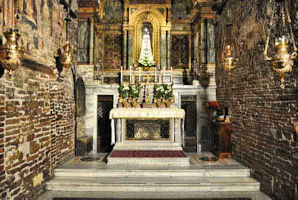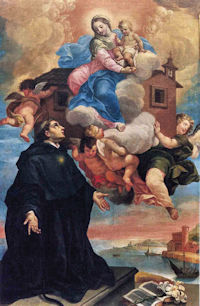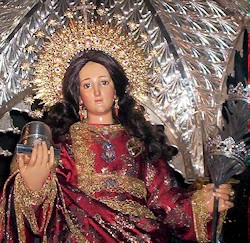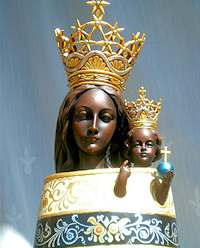Advent: December 10th
Saturday of the Second Week of Advent; Optional Memorial of Our Lady of Loreto
Other Commemorations: St. Eulalia, Virgin and Martyr (RM)
» Enjoy our Liturgical Seasons series of e-books!
In 2019 Pope Francis added this Optional Memorial of Our Lady of Loreto to the Universal Roman Calendar. The title Our Lady of Loreto refers to the Holy House of Loreto, the house in which Mary was born, and in which the Word was made flesh at the Annunciation. Tradition says that a band of angels scooped up the little house from the Holy Land, and transported it first to Tersato, Dalmatia in 1291, then Recanati, Italy in 1294, and finally to Loreto, Italy where it has been for centuries. It was this translation of the Holy House and the longstanding of the structure Our Lady of Loreto is the patron of builders, construction workers, and aviation. It is the first shrine of international renown dedicated to the Blessed Virgin, and has been known as a Marian center for centuries. Popes have always held the Shrine of Loreto in special esteem, and it is under their direct authority and protection. A replica of an ancient statue of Our Lady which is found there, one of the "Black Madonnas." The original statue made of cedar from Lebanon was destroyed in a fire in 1921.
The Roman Martyrology commemorates St. Eulalia of Merida (190-304), Spain's best known virgin martyr. Veneration of St. Eulalia was already popular with Christians by AD 350; relics from her were distributed through Iberia. Bishop Fidelis of Merida rebuilt a basilica in her honor around 560 AD. Her shrine was the most popular in Visigothic Spain. In 780 her body was transferred to Oviedo by King Silo. It lies in a coffin of Arab silver donated by Afonso VI in 1075. In 1639, she was made patron saint of Oviedo.
![]() Jesse Tree, Day 14 ~ Ruth
Jesse Tree, Day 14 ~ Ruth
Jesse Tree Overview
![]()
Our Lady of Loreto
 The shrine of the Holy House of Loreto is located along the Adriatic Sea coast of Italy, in a small town located three hours from Rome. The house has been said to have been miraculously transported from Palestine to Italy, and by the 14th century this shrine in Loreto is one of the most famous shrines of Our Lady in Europe.
The shrine of the Holy House of Loreto is located along the Adriatic Sea coast of Italy, in a small town located three hours from Rome. The house has been said to have been miraculously transported from Palestine to Italy, and by the 14th century this shrine in Loreto is one of the most famous shrines of Our Lady in Europe.
The large basilica provides the setting of the small house within the basilica itself. Though the rough walls of the little building have been raised in height and are cased externally in richly sculptured marble, the interior measures only thirty-one feet by thirteen feet.
Within the house an altar stands at one end beneath a statue, blackened over time from the smoke of burning candles and incense, of the Virgin Mother and her Divine Infant. The current statue is a 1920 replacement of damaged ancient original made of cedars of Lebanon. The replacement is made of cedar wood from the Vatican.
The inscription on the altar, Hic Verbum caro factum est, is a reminder that this building is honored by Christians as the house at Nazareth in which the Holy Family lived, and site of the Incarnation, when the Word became Flesh. Another inscription of the sixteenth century which decorates the eastern façade of the basilica sets forth at greater length the tradition which makes this shrine so famous.
Christian pilgrim, you have before your eyes the Holy House of Loreto, venerable throughout the world on account of the Divine mysteries accomplished in it and the glorious miracles herein wrought. It is here that most holy Mary, Mother of God, was born; here that she was saluted by the Angel, here that the eternal Word of God was made Flesh. Angels conveyed this House from Palestine to the town Tersato in Illyria in the year of salvation 1291 in the pontificate of Nicholas IV. Three years later, in the beginning of the pontificate of Boniface VIII, it was carried again by the ministry of angels and placed in a wood near this hill, in the vicinity of Recanati, in the March of Ancona; where having changed its station thrice in the course of a year, at length, by the will of God, it took up its permanent position on this spot three hundred years ago [now, of course, more than 600]. Ever since that time, both the extraordinary nature of the event having called forth the admiring wonder of the neighboring people and the fame of the miracles wrought in this sanctuary having spread far and wide, this Holy House, whose walls do not rest on any foundation and yet remain solid and uninjured after so many centuries, has been held in reverence by all nations.
—Adapted from The Catholic Encyclopedia.

Highlights and Things to Do:
- Why is Our Lady of Loreto connected with aviation? Read these two articles:
- Did angels really carry the Holy House of Mary to Loreto, Italy? at Catholic News Agency
- Our Lady of Loreto and Aviation from "All About Mary" at the University of Dayton
- Find out the connection the University of Notre Dame has with Our Lady of Loreto.
- Visit the website of Sanctuary of the Holy House of Loreto.
- Here is further reading about the Basilica of the Holy House (Basilica della Santa Casa).
- The Litany of Loreto originated from this Shrine. Read about the Litany of Loreto in Context.
- See The Illustrated Litany of Loreto for visual meditation on the Litany of Loreto.
St. Eulalia
 St. Eulalia descended from one of the most prominent families in Spain. She was educated in the Christian religion and was taught the sentiments of perfect piety. From her infancy she distinguished herself by an admirable sweetness of temper, modesty and devotion.
St. Eulalia descended from one of the most prominent families in Spain. She was educated in the Christian religion and was taught the sentiments of perfect piety. From her infancy she distinguished herself by an admirable sweetness of temper, modesty and devotion.
She showed a great love of the holy state of virginity, and by her seriousness and her contempt of dress, ornaments diversions and worldly company, she gave early signs of her sincere desire to lead a heavenly life on earth. Her heart was raised above the world before she was thought capable of knowing it, so that its amusements, which usually fill the minds of youth, had no charms for her, and every day of her life she continued to grow in virtue.
She was just twelve years old when the bloody edicts of the Emporer Diocletian were issued, by which it was ordered that all persons, without exception of age, sex, or profession, should be compelled to offer sacrifice to the gods of the empire.
Eulalia, although young, took the publication of this order as a sign of battle, but her mother, observing her impatient ardor for martyrdom, carried her into the country. However, the young saint quickly found a means to make her escape by night, and after much fatigue, arrived at Merida before daybreak.
That same morning, as soon as the court convened, she presented herself before the cruel judge, whose name was Dacian, and reproached him with impiety in attempting to destroy souls by compelling them to renounce the only true God.
The governor then commanded her to be seized. First, employing caresses, Dacian presented to her the advantages which her birth, youth and fortune gave her in the world and the grief which her disobedience would bring to her parents. Seeing that these temptations had no effect, he began to threaten her, placing the cruelest instruments of torture before her eyes, saying to her, "All this you shall escape if you will but touch a little salt and frankincense with the tip of your finger."
Provoked at these seducing flatteries, she threw down the idol, trampled upon the cake which was laid for the sacrifice and spat at the judge — an action only to be excused by her youth and inattention under the influence of a warm zeal, and fear of the snares which were laid before her.
Upon the judge's order, two executioners began to tear her tender sides with iron hooks, so as to leave the very bones bare. While this was happening, she called the strokes the trophies of Christ. Next, lighted torches were applied to her breasts and sides: under which torment, instead of groans, nothing was heard from her mouth but thanksgivings. The fire at length catching her hair surrounded her head and face, and the saint was stifled by the smoke and flame.
History says that a white dove seemed to come out of her mouth, and to wing its way upward when the holy martyr expired: at which prodigy the executioners were so much terrified that they fled and left the body.
Her relics are kept with great veneration at Oviedo, where she is honored as patroness. The Roman Martyrology mentions her name on December 10.
—Excerpted from Butler's Lives of the Saints
Patronage: Merida, Spain; Oviedo, Spain; runaways; torture victims; widows
Symbols and Representation: young woman with a cross, stake, and dove; naked young woman lying in the snow
Highlights and Things to Do:
- View this short YouTube video of the Fiesta of St. Eulalia in El Ramu, Spain to see how devotion to this saint is still celebrated.
- Read more about St. Eulalia:






